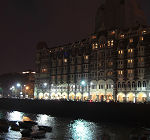On 26/11, Mumbaikars mourned for the fourth year, the terrorist siege of their city and the killing of their friends, families, guests and policemen. Along with the usual candlelight walks and ceremonies to remember the dead, was also the realization that India’s mega metropolis, financial and entertainment centre and sea port remains almost as vulnerable today as it was on 26th November, 2008.
There’s no way to lock Mumbai in, given its coastal location. What’s often referred to as the ‘resilience’ of Mumbaiwallahs is simply helplessness and a stoic bashing on. This has made unremarkable, and almost expected, a significant fact: that Mumbai has witnessed 11 major terrorist attacks, most by Pakistan-sponsored groups, in the last decade. It’s the most suffered by any major Indian city.
The impact they have had on Mumbai has been particularly poignant. For Mumbai is India’s most cosmopolitan city, where many religions have thrived, mixed and celebrated their diversity, where women are unafraid and have led movements from the front, where the Dalit movement, with its powerful literature, started. Maharashtra’s syncretic movements, Mahatma Gandhi’s civil disobedience and the uprisings by the ratings of the then-Royal Indian Navy in 1946 that accelerated the Independence movement, all emerged in Mumbai. The city looked forward and outward.
That expansiveness is what is being lost. So is the rich diversity within the Muslim and Hindu communities, both of which are now viewed as a single block, and whose expressions of faith are being appropriated by nativist forces like the Shiv Sena. Jammu & Kashmir was the issue between India and Pakistan; but terrorism is driving a wedge between the Hindu and Muslim communities in bindaas Mumbai.
This 26/11 was different from the previous three because of the hanging of Ajmal Kasab on 21st November – the only one of the 10 terrorists captured alive and convicted. The families of the victims who were killed this day may feel some vindication. But the continued denial by Pakistan about its role in sponsoring the 26/11 attacks, despite its own terrorist-related descent into chaos, bodes ill for India, Afghanistan and Pakistan itself. India is large enough, and its secular traditions strong enough to emerge from such assaults with its integrity assured; Afghanistan and Pakistan may not have such resilience.
Major terrorist attacks in Mumbai since 1993
| Sl.No. |
Date |
Place |
Killed
|
Injured
|
|
1
|
March 12, 1993 | 13 blasts across the city |
257
|
713
|
|
2
|
August 28, 1997 | Near Jama Masjid |
0
|
3
|
|
3
|
January 24, 1998 |
Malad |
0
|
1
|
|
4
|
February 27, 1998 |
Virar |
9
|
0
|
|
5
|
December 2, 2002 |
Ghatkopar |
3
|
31
|
|
6
|
December 6, 2002 |
Mumbai Central railway station |
0
|
25
|
|
7
|
January 27, 2003 |
Vile Parle |
1
|
25
|
|
8
|
March 13, 2003 |
Mulund Railway Station |
11
|
80
|
|
9
|
April 14, 2003 |
Bandra |
1
|
0
|
|
10
|
July 29, 2003 |
Ghatkopar |
3
|
34
|
|
11
|
August 25, 2003 |
Gateway of India and Zaveri Bazaar |
52
|
160
|
|
12
|
July 11, 2006 |
7 blasts at 7 locations in local trains across the city |
181
|
890
|
|
13
|
November 26, 2008 |
Multiple terrorist attacks across the city |
175
|
300
|
|
14
|
July 13, 2011 |
Serial blasts in Mumbai |
26
|
131
|
|
Total
|
719
|
2393
|
||
Source: South Asia Terrorism Portal and Institute of Conflict Management
This article was exclusively written for Gateway House: Indian Council on Global Relations. You can read more exclusive content here.
For interview requests with the author, or for permission to republish, please contact outreach@gatewayhouse.in.
© Copyright 2012 Gateway House: Indian Council on Global Relations. All rights reserved. Any unauthorized copying or reproduction is strictly prohibited.


